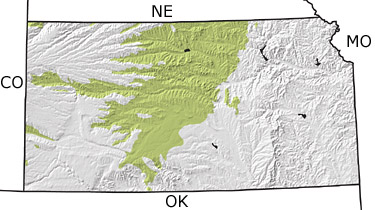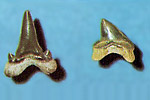Paleontology and geologyIn the early Cretaceous, Kansas was generally at or slightly below sea level. Rivers drained to the west, leaving behind shoreline and stream deposits. Swampy areas were rich in vegetation and these eventually formed coal deposits. Fossils are limited to plant material, some shallow water marine invertebrates, and, very rarely, a duckbilled or armored dinosaur. Later in the Cretaceous, the western seas deepened and open water marine conditions prevailed. These warm seas were home to sharks, mosasaurs, plesiosaurs, swimming birds, turtles, clams, fish, and crinoids. Pterosaurs roamed the skies. The remains of these animals were preserved in the soft, mucky ooze (now chalk) at the bottom of this ancient sea. This map indicates a broad band of Cretaceous rocks extending from the southwest to the northeast in the central part of the state. |


